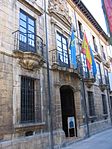Santa Eulalia, Morcín
Asturias geography stubsParishes in Morcin

Santa Eulalia is one of seven parishes (administrative divisions) in Morcín, a municipality within the province and autonomous community of Asturias, in northern Spain.
Excerpt from the Wikipedia article Santa Eulalia, Morcín (License: CC BY-SA 3.0, Authors, Images).Santa Eulalia, Morcín
Enlace de Santa Eulalia de Manzaneda, Oviedo
Geographical coordinates (GPS) Address Nearby Places Show on map
Geographical coordinates (GPS)
| Latitude | Longitude |
|---|---|
| N 43.316667 ° | E -5.816667 ° |
Address
Enlace de Santa Eulalia de Manzaneda
Enlace de Santa Eulalia de Manzaneda
33669 Oviedo
Asturias, Spain
Open on Google Maps









